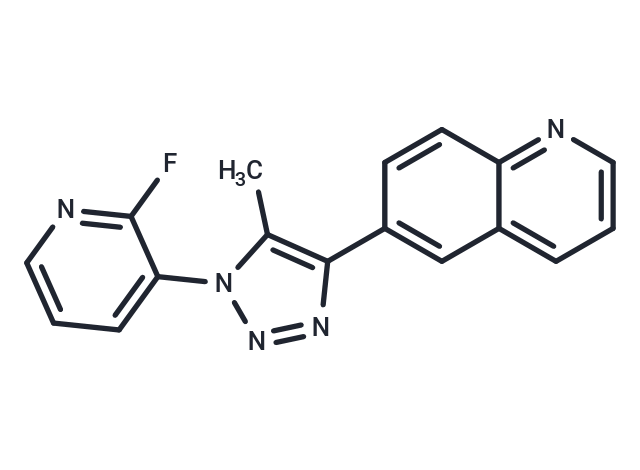Shopping Cart
- Remove All
 Your shopping cart is currently empty
Your shopping cart is currently empty

FPTQ is a highly effective antagonist of mGluR 1, displaying IC50 values of 6 nM and 1.4 nM for human and mouse mGluR1 respectively [1]. In addition to its robust inhibitory properties, FPTQ exhibits notable antioxidant and anti-inflammatory effects in both in vitro and in vivo settings [2].

| Pack Size | Price | Availability | Quantity |
|---|---|---|---|
| 1 mg | 43 € | In Stock | |
| 2 mg | 63 € | In Stock | |
| 5 mg | 107 € | In Stock | |
| 10 mg | 154 € | In Stock | |
| 25 mg | 310 € | In Stock | |
| 50 mg | 419 € | In Stock | |
| 100 mg | 556 € | In Stock | |
| 500 mg | Inquiry | In Stock | |
| 1 mL x 10 mM (in DMSO) | 112 € | In Stock |
| Description | FPTQ is a highly effective antagonist of mGluR 1, displaying IC50 values of 6 nM and 1.4 nM for human and mouse mGluR1 respectively [1]. In addition to its robust inhibitory properties, FPTQ exhibits notable antioxidant and anti-inflammatory effects in both in vitro and in vivo settings [2]. |
| In vitro | FPTQ, at concentrations ranging from 0.5 to 10 μM, exhibited no cytotoxic effects in RAW264.7 macrophage cells [2]. Furthermore, when administered at doses between 1 and 20 μM for a duration of 24 hours, FPTQ significantly inhibited LPS-induced NO production starting from concentrations above 1 μM. Specifically, a 10 μM dose of FPTQ resulted in a 31% reduction in oxidative stress [2]. Additionally, this compound markedly suppressed LPS-stimulated upregulation of pro-inflammatory cytokines IL-1β and IL-6 in a concentration-dependent manner. At 10 μM, FPTQ was found to decrease the mRNA levels of IL-1β and IL-6 by 27% and 44%, respectively, illustrating its potent anti-inflammatory properties in RAW264.7 macrophage cells [2]. This was further supported by RT-PCR analysis, confirming the downregulation of these cytokines [1]. |
| In vivo | Neutrophils translocation in the zebrafish tail-transected model was inhibited by FPTQ. Neutrophil aggregation was also inhibited by FPTQ in the LPS-stimulated zebrafish model. FPTQ (5-20 μM) decreases the number of neutrophils migrating to the amputation site in zebrafish larvae by tail amputation. In the tailfin wound method, the number of neutrophils collecting at the wound site also decreases in a dose-dependent manner in zebrafish [2].In a LPS-induced inflammation zebrafish model, LPS solution is injected into the yolks of Tg(mpx:EGFP) i114 zebrafish larvae and exposed the zebrafish larvae immediately to FPTQ treatment.FPTQ (20 μM; 4 hours) significantly decreases the fluorescent neutrophils after yolk injection and has an anti-inflammatory effect during the early phase of inflammation [2]. |
| Molecular Weight | 305.31 |
| Formula | C17H12FN5 |
| Cas No. | 864863-72-9 |
| Smiles | Cc1c(nnn1-c1cccnc1F)-c1ccc2ncccc2c1 |
| Storage | Powder: -20°C for 3 years | In solvent: -80°C for 1 year | Shipping with blue ice. | ||||||||||||||||||||
| Solubility Information | DMSO: 4.4 mg/mL (14.41 mM), Sonication is recommended. | ||||||||||||||||||||
Solution Preparation Table | |||||||||||||||||||||
DMSO
| |||||||||||||||||||||

Copyright © 2015-2025 TargetMol Chemicals Inc. All Rights Reserved.